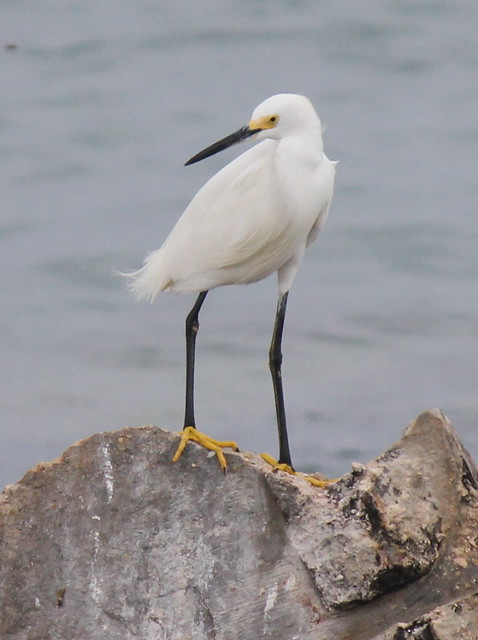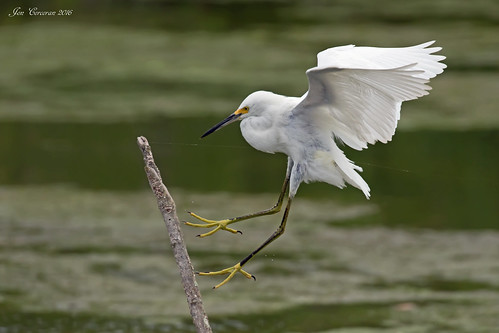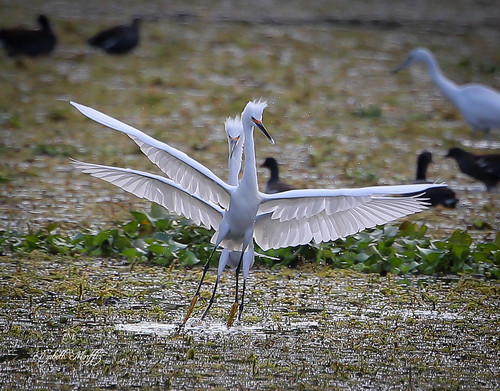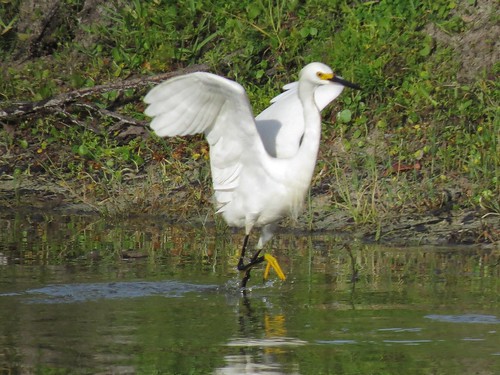Snowy Egret
(Egretta thula)
Conservation • Description • Habitat • Ecology • Distribution • Taxonomy
Conservation Status |
|
|||||||
| IUCN Red List | LC - Least Concern |
|||||||
| NatureServe | N5B, N5N - Secure Breeding and Nonbreeding SNA - Not applicable |
|||||||
| Minnesota | not listed |
|||||||
Description |
||
The bill is black. The legs are black. The feet are yellow. |
||
Size |
||
22″ to 26″ in length 42″ wingspan |
||
Voice |
||
Similar Species |
||
Cattle Egret (Bubulcus ibis) bill and legs are orange. Great Egret (Ardea alba) is much larger. The bill is yellow. The feet are black. |
||
Habitat |
||
Marshes, lakes, and ponds |
||
Ecology |
||
Migration |
||
Spring and fall |
||
Nesting |
||
|
||
Food |
||
|
||
Distribution |
||||
Occurrence |
||||
Occasional to rare migrant |
||||
Maps |
||||
The Minnesota Ornithologists’ Union All Seasons Species Occurrence Map |
||||
Taxonomy |
|||
| Class | Aves (birds) | ||
Order |
Pelecaniformes (pelicans, herons, ibises, and allies) | ||
Family |
Ardeidae (bitterns, egrets, herons) | ||
Subfamily |
Ardeinae (typical herons and egrets) | ||
Genus |
Egretta (typical egrets) | ||
Bitterns, egrets, and herons (family Ardeidae) were formerly classified under the order Ciconiiformes. Based on a phylogenomic study published in 2008, the family was transferred to the order Pelecaniformes. |
|||
Subordinate Taxa |
|||
Brewster’s Snowy Egret (Egretta thula brewsteri) Snowy Egret (Egretta thula thula) |
|||
Synonyms |
|||
|
|||
Visitor Photos |
|||||
Share your photo of this bird. |
|||||
| This button not working for you? Simply email us at info@MinnesotaSeasons.com. Attach one or more photos and, if you like, a caption. |
|||||
J. Jones |
|||||
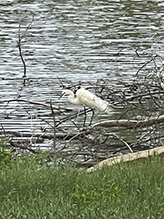 |
|||||
MinnesotaSeasons.com Photos |
|||||
|
|||||


Visitor Videos |
|||
Share your video of this bird. |
|||
| This button not working for you? Simply email us at info@MinnesotaSeasons.com. Attach a video, a YouTube link, or a cloud storage link. |
|||
Other Videos |
|||
| Snowy Egret Fishing Larry Jordan |
|||
About
Uploaded on Oct 23, 2011 The Snowy Egret has the largest repertoire of foraging behaviors of all North American herons according to Birds of North America Online. You will see several of them in this four minute video. The first and most often used foraging behavior of this beautiful egret involves stirring up the mud with the feet. You will see this behavior in the first 30 seconds of the video. |
|||
| Snowy Egret's Nest | National Geographic National Geographic |
|||
About
Uploaded on Dec 28, 2007 In a cruel Darwinian struggle, baby egrets see who will stay in the nest, and who will be sacrificed to the alligator waiting below. About National Geographic: Get More National Geographic: Snowy Egret's Nest | National Geographic National Geographic |
|||
| Snowy Egret Fishing - Oh those Yellow Feet! MyBackyardBirding |
|||
About
Published on Feb 15, 2016 Beautiful Snowy Egret with bright yellow feet, uses them to help stir up fish while hunting. Unlike most herons that patiently sit and wait to strike a fish, the Snowy Egret is on the move - stirring up the bottom and exciting fish with those big yellow feet and covering a lot of ground to stalk fish. Snowy Egrets are one of my favorite birds with their striking pure white plumage and sexy yellow feet they always make my day! If you've never seen on on the move you are in for a treat! New HD videos uploaded frequently. Subscribe at: More info at: http://screech-owls.blogspot.com/2016/02/snowy-egret-fishing-oh-those-yellow-feet.html |
|||
| Snowy Egret feeding frenzy Van Remsen |
|||
About
Published on Sep 10, 2015 Thousands of Snowy Egrets (and other species), South Farm, Sherburne WMA, LA, 9-10-15 |
|||
| Snowy Egret (Egretta thula) feeding at Good Harbor Beach Gloucester Massachusetts Kim Smith |
|||
About
Uploaded on Jul 16, 2011 Filmed at Good Harbor Beach Gloucester, Massachusetts, July 13, 2011. The Snowy Egret (Egretta thula) is easily distinguished from the Great Egret (Casmerodius albus) by its smaller size, plume of feathers atop its head, and bright, sunny yellow feet. The Snowy Egret is about 24 inches long and weighs approximately 13 ounces. The Great Egret is roughly 37-40 inches long and weighs about 35 ounces. Plume hunters for the millinery trade hunted both species of egrets to near extinction by the turn of the previous century. Under the Migratory Bird Treaty Act, the Snowy is protected by US law and the population has rebounded. The Snowy Egret's diet is diverse, consisting primarily of shrimps, snails, small fish, frogs, and aquatic insects. Snowys stalk prey in shallow water, and in the video, you can see it flushing prey into view by shaking and shuffling its feet. While filming (see last half minute of video), the Snowy stepped out of the water, turned gracefully towards the camera, and stood for a moment--providing more than a quick glimpse of it's substantial, bright cadmium lemon feet. |
|||

Last Updated:
